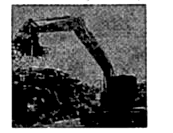Magnets are used in cranes for lifting and moving scrap metals.
Step-by-Step Solution:
1. Understanding the Use of Magnets in Cranes:
- Magnets are commonly used in cranes to lift and move heavy materials, specifically scrap metals.
2. Type of Magnet Used:
- The magnets used in cranes are typically electromagnets. Unlike permanent magnets, electromagnets can be turned on and off, making them ideal for lifting operations.
3. Mechanism of Electromagnets:
- An electromagnet consists of a coil of wire (often wrapped around a core made of iron) that becomes magnetized when an electric current flows through it.
4. Activation of the Electromagnet:
- When electricity is passed through the coil, the large disc attached to the crane becomes a powerful magnet. This is due to the magnetic field generated by the electric current.
5. Attraction of Scrap Metals:
- The powerful magnetic field attracts ferromagnetic materials, such as scrap iron and steel. This allows the crane to lift and transport these heavy materials easily.
6. Conclusion:
- Therefore, the statement that "magnets are used in cranes for lifting and moving scrap metals" is true. The use of electromagnets in cranes enhances efficiency in handling scrap materials.
- Magnets are commonly used in cranes to lift and move heavy materials, specifically scrap metals.
- The magnets used in cranes are typically electromagnets. Unlike permanent magnets, electromagnets can be turned on and off, making them ideal for lifting operations.
- An electromagnet consists of a coil of wire (often wrapped around a core made of iron) that becomes magnetized when an electric current flows through it.
- When electricity is passed through the coil, the large disc attached to the crane becomes a powerful magnet. This is due to the magnetic field generated by the electric current.
- The powerful magnetic field attracts ferromagnetic materials, such as scrap iron and steel. This allows the crane to lift and transport these heavy materials easily.
- Therefore, the statement that "magnets are used in cranes for lifting and moving scrap metals" is true. The use of electromagnets in cranes enhances efficiency in handling scrap materials.
Topper's Solved these Questions
- MODEL TEST PAPERS BOOK - ICSECHAPTER - MODEL TEST PAPERS EXERCISE - TEST PAPER I (SECTION I) Choose the correct option to fill in the blank.
5 Videos
- MODEL TEST PAPERS BOOK - ICSECHAPTER - MODEL TEST PAPERS EXERCISE - TEST PAPER I (SECTION I) Circle the odd one.
5 Videos
- MODEL TEST PAPERS BOOK - ICSECHAPTER - MODEL TEST PAPERS EXERCISE - TEST PAPER I (SECTION I) Choose the correct option
4 Videos
- MATTERBOOK - ICSECHAPTER - MATTEREXERCISE - Picture Based Questions
2 Videos
- PHYSICAL QUANTITIES AND MEASUREMENT BOOK - ICSECHAPTER - PHYSICAL QUANTITIES AND MEASUREMENT EXERCISE - Picture-Based Questions
1 Videos
Similar Questions
Knowledge Check
Name the pulley system used in the following application of lifting scrap from a junk yard:
 ASingle fixed pulleyBSingle movable pulleyCCombination of single fixed and single movable pulleyDBlock and tackle system of pulleys
ASingle fixed pulleyBSingle movable pulleyCCombination of single fixed and single movable pulleyDBlock and tackle system of pulleysAssertion : Magnetic field interacts with a moving charge and not with a stationary charge.
Reason : A moving charge produces a magnetic field.AIf both assertion and reason are true and reason is the correct explanation of assertion.BIf both assertion and reason are true but reason is the correct explanation of assertion.CIf assertion is true but reason is falseDIf both assertion and reason are false.
A: The magnetic field always accelerates a moving charge if the moving charge cuts the field lines.
R: When a moving charge cuts the magnetic field lines, the magnetic force on the charge is always non zero.
View SolutionA spring balance and a physical balance are kept in a lift. In these balance equal masses are placed. If now the lift starts moving upward with constant acceleration, then.
View SolutionA spring balance and a physical balance are kept in a lift. In these balance equal masses are placed. If now the lift starts moving upward with constant acceleration, then.
View SolutionIt is established that an electric current through a metallic conductor produces a magnetic field around it. Is there a similar magnetic field produced around a thin beam of moving (i) alpha particles, (ii) neutrons? Justify your answer.
View SolutionDiscuss how apparent weight of a person in a lift changes when it is (a) moving up with acceleration (b) moving down with acceleration less than acceleration due to gravity (c) moving with uniform velocity (d) when it is stationary.
View SolutionA: When a bar magnet is dropped into a vertical long hollow metallic tube, the magnet ultimately moves with zera acceleration.
R: The magnet falling into metallic tube causes the eddy currents in the metal tube, so the motion of the magnet is damped.
View Solution
